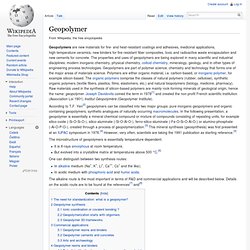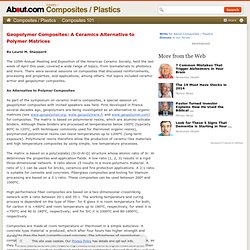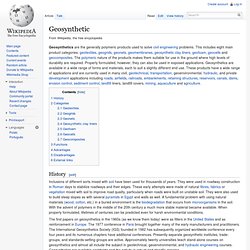

Geopolymers. Geopolymers are new materials for fire- and heat-resistant coatings and adhesives, medicinal applications, high-temperature ceramics, new binders for fire-resistant fiber composites, toxic and radioactive waste encapsulation and new cements for concrete.

The properties and uses of geopolymers are being explored in many scientific and industrial disciplines: modern inorganic chemistry, physical chemistry, colloid chemistry, mineralogy, geology, and in other types of engineering process technologies. Geopolymers are part of polymer science, chemistry and technology that forms one of the major areas of materials science. Polymers are either organic material, i.e. carbon-based, or inorganic polymer, for example silicon-based.
The organic polymers comprise the classes of natural polymers (rubber, cellulose), synthetic organic polymers (textile fibers, plastics, films, elastomers, etc.) and natural biopolymers (biology, medicine, pharmacy). According to T.F. For chemists[11] '... New 'green' geopolymer concrete delivers win-win for industry and the planet.
'Green' research at Louisiana Tech has resulted in new geopolymer concrete technology, like this 5,000lb concrete block cast using fly ash Concrete is the most prevalent building material on the planet, and though the world would be pretty flat without it (not many tall buildings and structures), it does come at a price – around 5-8 percent of all human-generated atmospheric CO2 comes from the concrete industry.

A culprit is Portland cement, the binding agent in concrete. It’s the most widely produced man-made material on earth. Production of Portland cement is currently exceeding 2.6 billion tons per year worldwide and growing at 5 percent annually. To halt these alarming pollution figures, innovative research on geopolymer concrete, along with ways of using a waste byproduct from coal-fired powerplants, is being conducted by Dr Erez Allouche, assistant professor of civil engineering at Louisiana Tech University and associate director of the Trenchless Technology Center. Geopolymer Laboratory - Fundamental Basis. Geopolymer Composites: A Ceramic Alternative to Polymer Matrices. By Laurel M.

Sheppard The 105th Annual Meeting and Exposition of the American Ceramic Society, held the last week of April this year, covered a wide range of topics, from biomaterials to photonics and more. There were several sessions on composites that discussed reinforcements, processing and properties, and applications, among others. Hot topics included ceramic armor and geopolymer composites. An Alternative to Polymer Composites As part of the symposium on ceramic matrix composites, a special session on geopolymer composites with invited speakers was held.
The matrix is based on a poly(sialate) (Si-O-Al-O) structure whose atomic ratio of Si: Al determines the properties and application fields. Geopolymer House Blog. Geopolymers: Structures, Processing, Properties and Industrial Applications. Geopolymer Institute. Geopolymer chemistry and applications. The Pyramids: An Enigma Solved. Why the pharaohs built the Pyramids with fake stones. Joseph Davidovits - Geopolymer Institute. My Blogspot: My Matrix Solutions Affiliate link: My Zeolite Affiliate link: Winning With Code Pleading Interview w/ David Williams: 485695&cmd=apop The Right of Self-Determination is about Self-governing. It is a choice and that choice was succinctly stated by Theodore Roosevelt in the Jamestown Exposition on April 26, 1907; when he said: "It behooves us to remember that men can never escape being governed. The Artificial Womb- From the time a person leaves its mother's womb, its every effort is directed towards building, maintaining, and withdrawing into artificial wombs, various sorts of substitute protective devices or shells.
The objective of these artificial wombs is to provide a stable environment for both stable and unstable activity; to provide a shelter for the evolutionary processes of growth and maturity - i.e., survival; to provide security for freedom and to provide defensive protection for offensive activity. This is equally true of both the general public and the elite. Geosynthetic. History[edit] Inclusions of different sorts mixed with soil have been used for thousands of years.

They were used in roadway construction in Roman days to stabilize roadways and their edges. These early attempts were made of natural fibres, fabrics or vegetation mixed with soil to improve road quality, particularly when roads were built on unstable soil. They were also used to build steep slopes as with several pyramids in Egypt and walls as well. A fundamental problem with using natural materials (wood, cotton, etc.) in a buried environment is the biodegradation that occurs from microorganisms in the soil. The first papers on geosynthetics in the 1960s (as we know them today) were as filters in the United States and as reinforcement in Europe. Collage of geosynthetic products Categories[edit] Geotextiles[edit] Geotextiles form one of the two largest groups of geosynthetics.
Geogrids[edit] Geogrids represent a rapidly growing segment within geosynthetics. Geonets[edit] Geofoam[edit] The Geosynthetic Institute ( GSI ) GeoSynthesis 2011.